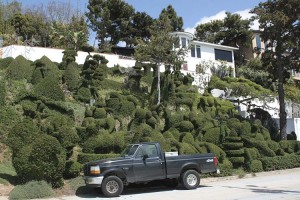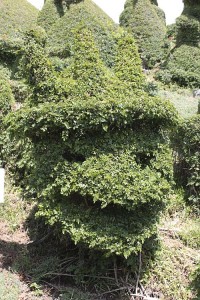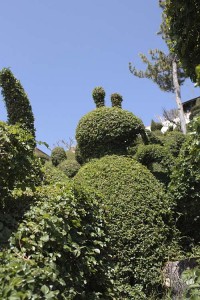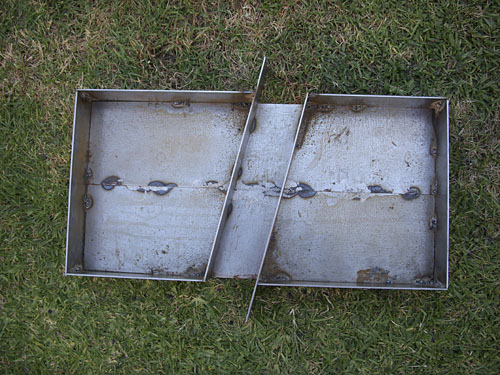I posted a couple months ago about the presence here in town of an extreme topiary garden. At that point I hadn’t had a chance to visit it, but last week I finally made it.
The house responsible for the garden perches high above the street. The owner could have chosen to plant groundcover on the long slope, or to terrace it and garden the different levels. Instead they opted to populate the slope with several dozen crazy little topiaries. Some of them are geometric, but most are fanciful little figures. Bunnies, sea monsters, Texas gunslingers, you name it.
The plants making up all the figures appeared to be cape honeysuckle, Tecomaria capensis, a plant that isn’t one of the classic topiary selections. But it accepts shaping really well, and seems to be a good choice for topiary if you don’t mind a little bumpiness here and there. The plant can have spectacular tubular orange flowers, though don’t expect to see many if you’re sculpting a giant bunny out of it.
A spectacle like this doesn’t just happen, so it was no surprise that I found a gardener maintaining it. I was hoping to see someone shaping the topiaries. But instead he was using an electric hedge trimmer to keep the plants off the stairs that led up (and up and up) to the house. But I guess that’s gardening for you. There’s a certain amount of the really gratifying work of putting in new plants or admiring the flowers, but there’s a lot of basic maintenance that goes into it as well…
Speaking of things topiary, I finally had a chance to see A Man Named Pearl, the 2006 documentary on Pearl Fryar’s amazing topiary garden in Bishopville, South Carolina. The basic story is inspiring: a sharecropper’s son moves into a white neighborhood where his presence isn’t appreciated at first; over time he makes a garden that is awarded “Yard of the Month”; and then he goes on to shape a collection of some of the most original topiaries ever clipped. Some of you have seen the documentary already–particularly now that HGTV has broadcast it. But if you haven’t, it’s definitely worth a look.












large/05baretrees.gif)
large/13espalier.jpg)
%20large/03gettycactus.jpg)